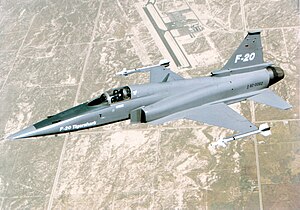Northrop F-20
| Northrop F-20 Tigershark | |
|---|---|
 F-20 "Tigershark" (S / N 82-0062) of the United States Air Force |
|
| Type: | Light fighter aircraft |
| Design country: | |
| Manufacturer: | |
| First flight: |
August 30, 1982 |
| Commissioning: |
Flight tests ended in 1986 |
| Production time: |
Was never mass-produced |
| Number of pieces: |
3 |
The Northrop F-20 Tigershark is a further development of the Northrop F-5 Tiger , which is why it was initially also referred to as the F-5G. The Tigershark was inferior to the General Dynamics F-16 in terms of performance, which is why there was no order from the United States Air Force for the F-20.
description
The airframe of the F-20 was largely based on that of the F-5, but an EFIS cockpit was now used. In order to reduce the production and maintenance costs, a single-jet design with a General Electric F404- GE-100 engine was chosen, which, however, was significantly more powerful than the two engines of the F-5. Although two prototypes were lost, the F-20 showed a reliability of 97%. The performance of the machine has been significantly improved compared to the original model, and expectations have been exceeded.
Initially three copies were made, the first of which took off in August 1982. After two machines were lost, construction of a fourth cell began. However, after the United States Air Force opted for the General Dynamics F-16 in 1986, work was discontinued. Some countries, including Germany and Switzerland , expressed interest in the machine. South Korea and India wanted to buy the manufacturing rights and drawings from Northrop. The United States Congress , however, prevented a technology transfer , as one saw the export opportunities of the F-16 impaired, whereupon Northrop abandoned the program.
Technical specifications

| Parameter | Data |
|---|---|
| Type: | single-seat tactical fighter |
| Length: | 14.40 m |
| Wingspan: | 8.53 m |
| Wing area: | 17 m² |
| Wing extension : | 4.28 |
| Wing loading : |
|
| Height: | 4.20 m |
| Empty weight: | 5,090 kg |
| Normal takeoff weight: | 6,830 kg |
| Maximum take-off weight: | 11,920 kg |
| Top speed: | Do 2.1 or 2,334 km / h at the optimal altitude |
| Service ceiling: | 17,315 m |
| Maximum rate of climb: | 255 m / s |
| Use radius: | 555 km |
| Transfer range: |
|
| Engines: | a General Electric F404-GE-100 turbofan engine |
| Thrust: |
|
| Thrust-to-weight ratio : |
|
Armament
- 2 × 20 mm M39A2 cannons with 280 rounds
- 5 × external load carriers for a weapon load of up to 3,600 kg:
- 30 mm cannon container GPU-5 / A
- 2 × AIM-7F Sparrow
- 6 × AIM-9 Sidewinder
- 4 × AGM-65 Maverick
- 9 × Mk-82 bombs
- 4 × Paveway laser steering bombs
Trivia
In a spot of Peugeot from 2014 parts are used an F-20 promotional film.
Web links
Individual evidence
- ↑ Northrop F-20 Tigershark: The bestseller that wasn't , Flugrevue from August 24, 2019.
- ↑ David Donald (ed.): "Northrop F-5 family". "Northrop F-20A Tigershark". The Complete Encyclopedia of World Aircraft. New York: Barnes & Noble Books, 1997, pp. 708. ISBN 0-7607-0592-5 .
- ↑ Peugeot commercial

